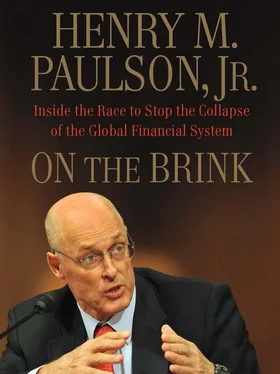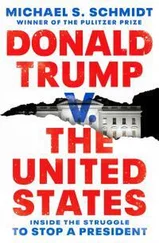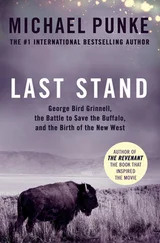Someone raised the possibility of the government’s giving BofA a support package similar to Citi’s. Ben replied that Citi had received federal assistance because of systemic risk, not to facilitate the close of a merger. If a systemic risk existed after BofA’s merger with Merrill closed, we should address it at that time, Ben said.
Ben and I indicated that Treasury and the Fed were committed to preventing the failure of any systemically important institution. By the end of the meeting, BofA had agreed to work closely with the Fed to provide the necessary information so that we could better understand the situation; we, in turn, would give them more details of the structure of the Citi bailout. We left the meeting knowing we had a lot of work to do to get all the facts about the nature of the losses and what had caused them.
With the U.S. falling further into recession, I was deeply concerned about being caught short of funds. Merrill Lynch’s staggering fourth-quarter losses now threatened the viability of two huge institutions, with combined assets of $2.7 trillion, and raised the specter of a costly rescue of Bank of America. Add to that the impending auto bailout, and TARP would be drained even further. January 20 was only 33 days away, but that would seem an eternity if I didn’t have sufficient funds to deal with any crisis that arose.
I arrived at the office on Friday, December 19, at 7:15 a.m. with renewed determination to get Tim Geithner or Larry Summers to persuade Obama to work with us to take down the last tranche right after the holidays. The previous afternoon the president had given me his final instructions on the autos, and I had asked my Treasury team to negotiate through the night so that we could announce a deal before the market opened.
We had expected President Bush to announce his auto deal at 10:00 a.m., only to learn he would now do so an hour earlier. That left us scrambling to finalize the term sheet, which we did only two minutes before the president went on air from the White House. The government would loan Chrysler $4 billion and GM a total of $13.4 billion from TARP—with $4 billion of the GM loan dependent on Congress’s releasing the last tranche.
Although we wanted the car companies to restructure to increase their long-term viability, we would not be around to oversee these changes. So we crafted terms that would put the automakers on a path to reorganization through bankruptcy proceedings and would make it difficult for President Obama to avoid that outcome. We did this by requiring the companies to submit in mid-February restructuring plans to demonstrate how they would achieve financial viability and repay the loans. They would have to come up with a competitive product mix and cost structure; our terms required significant concessions by labor and creditors. If the conditions were not met by March 31, the government would call in the loan, forcing a restructuring under bankruptcy. We knew it would be almost impossible to win major concessions from all parties without this pressure.
After all the activity of the past few months, this was the first time Treasury had worked so closely with the White House, and I was very proud of my team for executing such a crucial deal so well in such a short period of time.
That same day, December 19, I learned from Ben that Bank of America had gone back to the Fed to say that the Merrill Lynch situation was getting worse: its estimated losses now stood at $22 billion pretax. Midafternoon I called Ken Lewis to find out how the losses had increased by $4 billion in two days. He said he was trying to understand that himself. I remained adamant that he needed to close the Merrill deal.
An hour later, Ben and I got on a conference call that included Ken and his BofA team and what seemed to be dozens of Fed officials from the Washington, Richmond, and New York Reserve banks. The New York Fed was represented by senior vice president Art Angulo and general counsel Tom Baxter.
Ken said that his board was still considering invoking the MAC, but the New York Fed officials pushed back hard, questioning its enforceability. I weighed in, offering my belief that invoking the MAC would pose a risk to BofA and the entire system. Ken raised the idea of using the clause to renegotiate the terms of the deal with Merrill, and I answered that this would cause the same concerns as invoking the MAC to get out of the deal: it would create an extended period of uncertainty in a market that already was being driven by fear. We agreed that we needed to learn more and that we would talk again early the following week.
The next afternoon, I flew to Colorado for a few days of skiing with my family over Christmas. On Sunday morning, Ken Lewis called me. The usually calm CEO sounded shaken. He reiterated that his board was concerned about Merrill’s losses and was still weighing the MAC. They needed to make a decision before the deal closed on January 1, he said. I told him that Treasury and the Fed were committed to saving any systemically important institution and reminded him that we would work on a support package, if needed. “You know how strongly we feel about this,” I said.
Since we had been so clear about our commitment to a government support program, I doubted that Ken was just testing us. Indeed, I concluded from earlier conversations that Ken himself was unsure about what kind of government help was appropriate or needed. He seemed to be having a difficult time with his board.
I got back to Ken later and again emphasized to him that the government would not let any systemically important institution fail; that exercising the MAC would show a colossal lack of judgment by BofA; that such an action would jeopardize his bank, Merrill Lynch, and the entire financial system; and that under such circumstances, the Fed, as BofA’s regulator, could take extreme measures, including the removal of management and the board.
“I understand,” Ken said. “Let’s de-escalate.”
The next day, Ben called me to tell me he had confirmed that Ken and BofA’s board were going ahead with the Merrill deal, but the board wanted a letter from the government committing to a support package.
“Ben,” I said, “that doesn’t make any sense.”
“I know,” he said.
“I will call Lewis back and handle it,” I said.
I called the BofA CEO and told him straightaway: “Ken, we can’t give you a letter.”
We had not yet committed to a plan for helping BofA, let alone worked out all the details of such a plan, I explained. Ben and I had already said publicly that we wouldn’t let a systemically important institution fail. A letter could only reiterate that stance. But Treasury would have to disclose the letter publicly, and that would only raise more concerns in the market. Ken said he understood and would tell his board.
On New Year’s Eve, I got another call from Ken. He said he was closing the Merrill Lynch deal the next day and told me that he trusted me to make sure the government would come up with a program for BofA.
The deal closed on January 1.
Last Days
Though we had worked out the TARP loans to the automakers, their stressed financial units presented another problem. GMAC Financial Services lacked sufficient capital, and Chrysler Financial had liquidity issues—as a result, neither unit could provide the credit that dealers and customers needed to get sales moving again. On December 29, Treasury announced a $5 billion capital infusion from TARP into GMAC, which had become a bank holding company, along with an additional $1 billion for GM to invest in GMAC. On January 16, Treasury committed $1.5 billion of TARP funds to Chrysler Financial, to make new loans to car buyers.
We worked hard to make sure the Obama team would have some breathing room when they settled into the White House, and no one cared more about this than President Bush. He went out of his way to make things easier for the new administration.
Читать дальше












